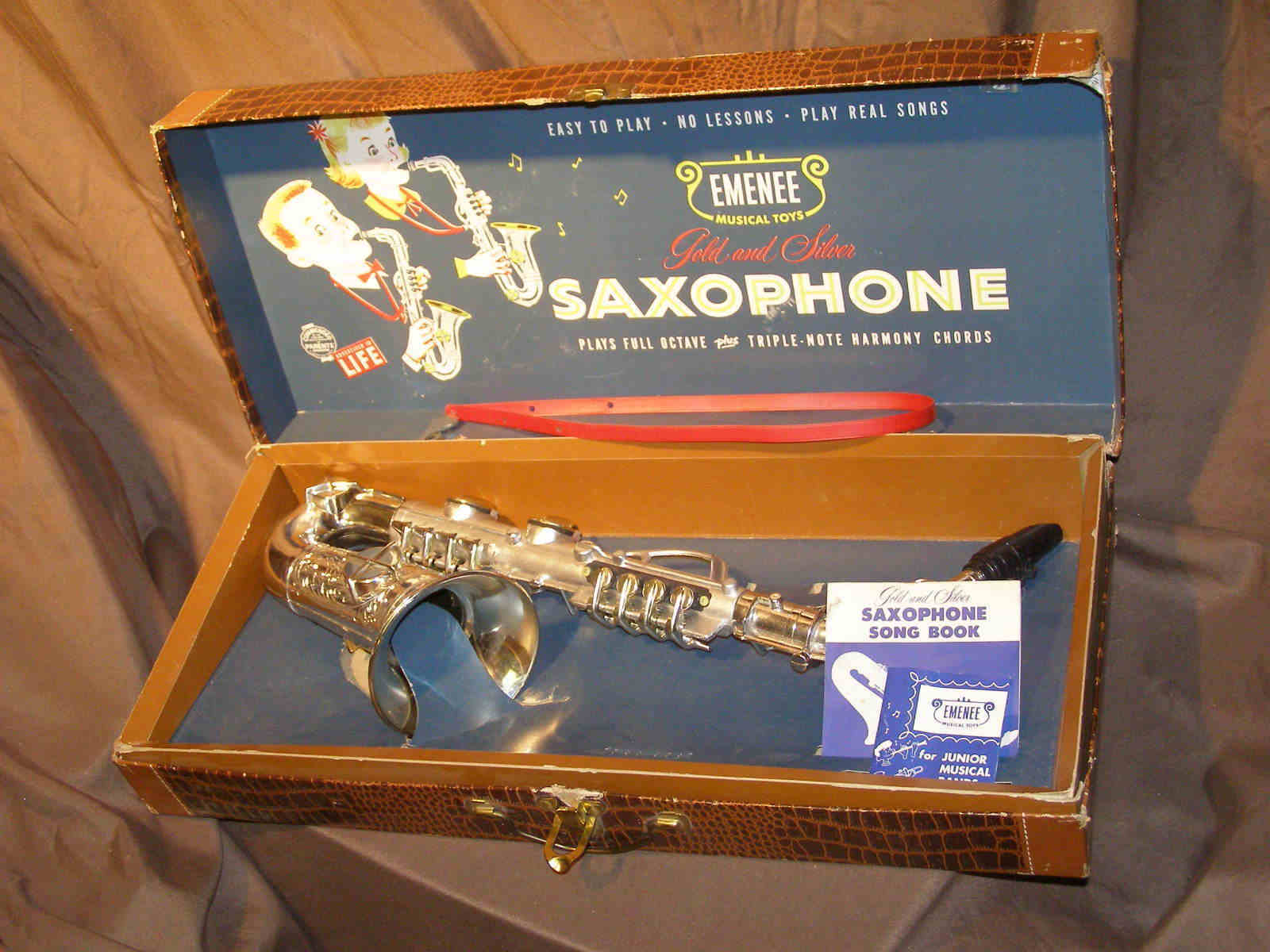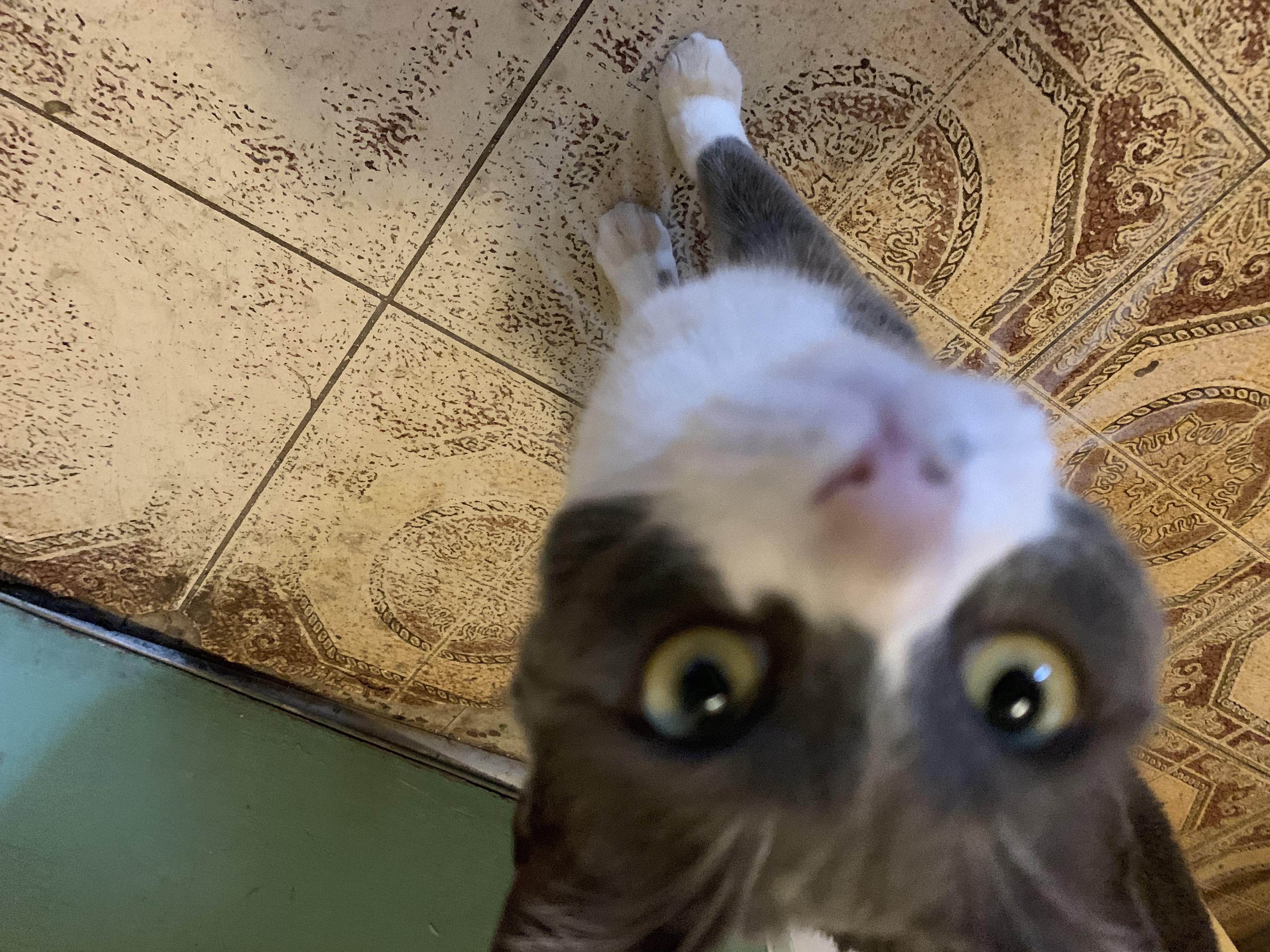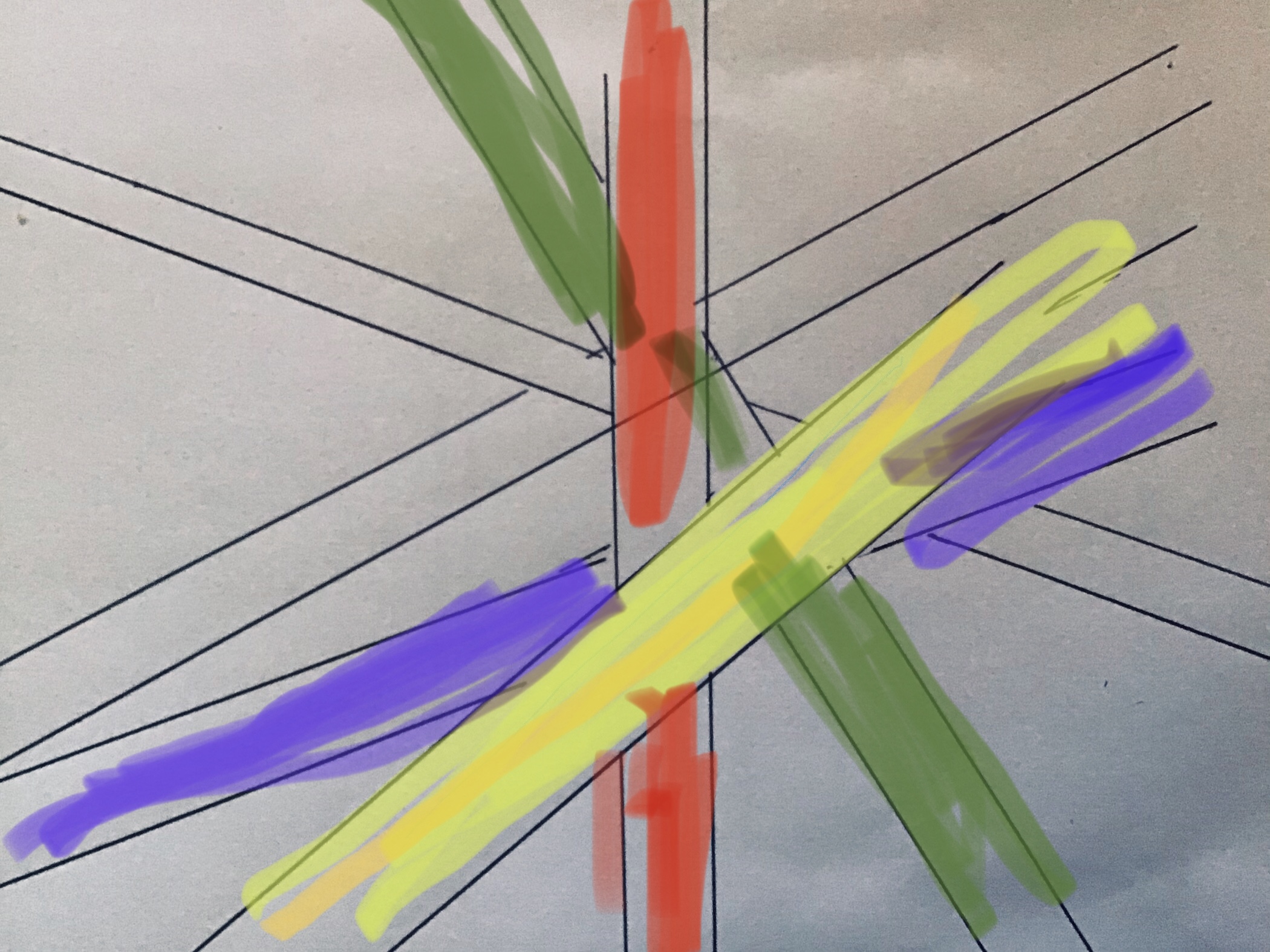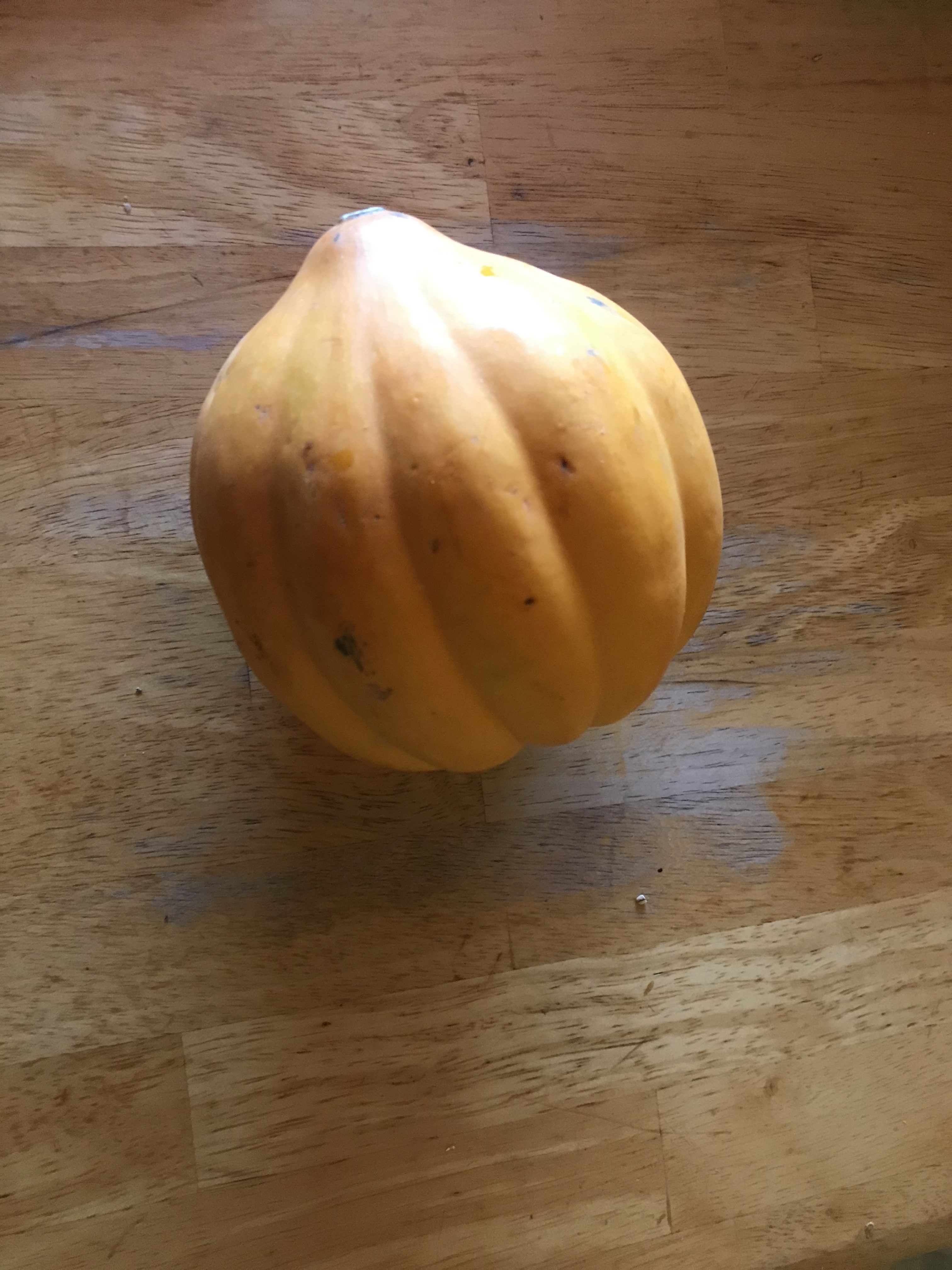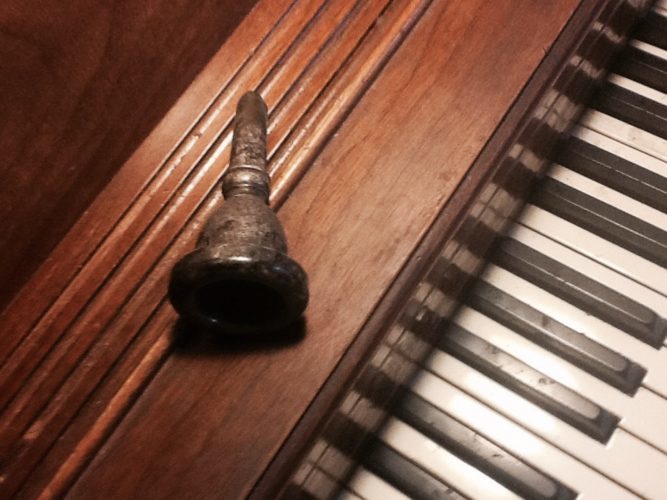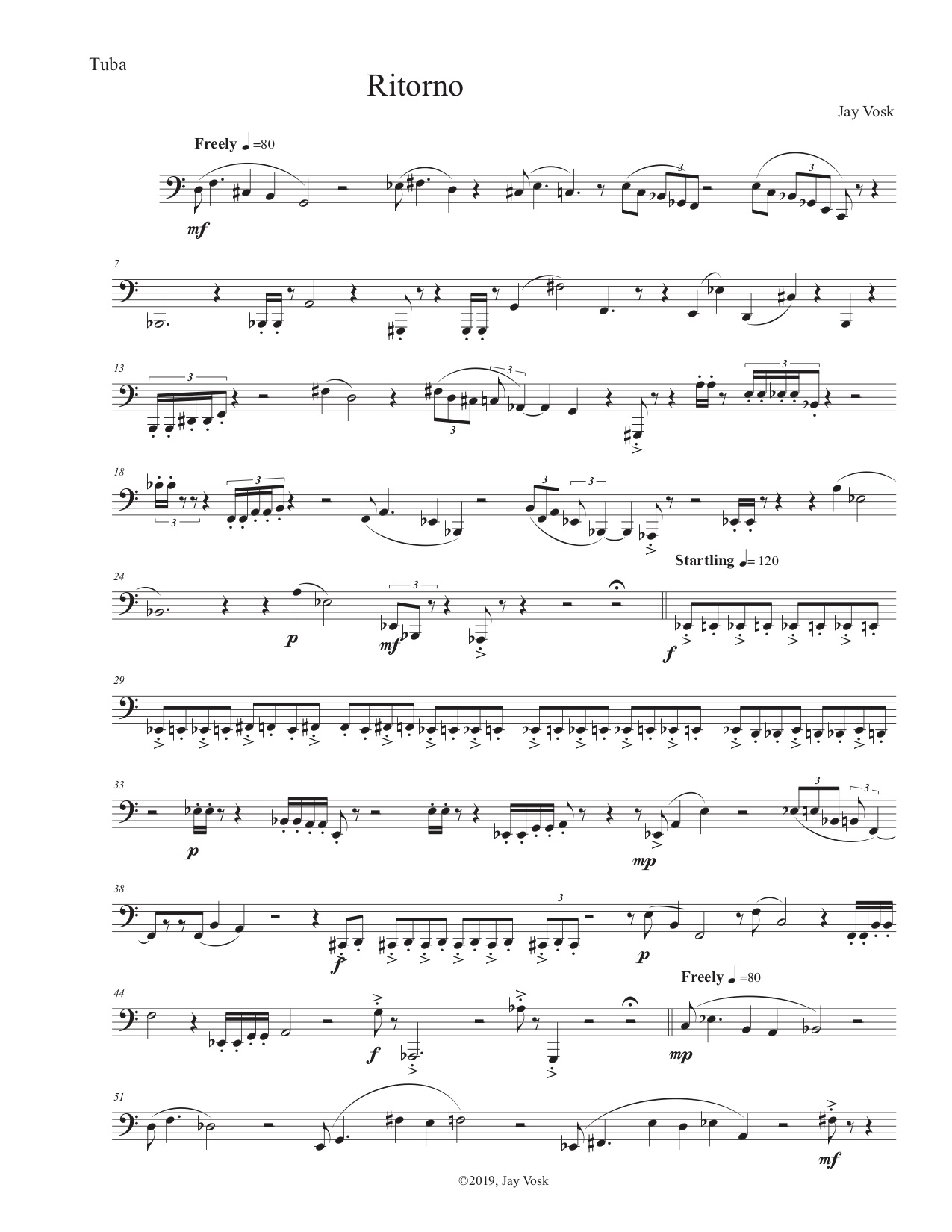I was in third grade and was more than rarin' to go and start playing the saxophone.My parents were well aware of this, and so right around Chanukah of 1956, they alerted my grandparents as to the perfect gift for me. That gift was a saxophone, well, not a real saxophone, a toy saxophone. The company that made them was called Emenee. They made a number of fake wind instruments like trumpets and clarinets.. They all sounded like cheap harmonicas. So I just unwrapped my gift and played away. It had levers for keys and I ‘mastered’ the instrument right away. I just had to use my imagination and I was sort of playing the saxophone.But soon I was bored of the thing. I had to wait another year, until fourth grade when kids were allowed to choose their musical instrument for the school band.The day before our first band class my mother and a I went to the music store to get the saxophone. As soon as we got home, my mom and I somehow figured out how to put it together, reed and all. I spent much of the remainder of that day exploring the instrument and discovering a number of pitches. The next day was our first band class and the Mr. Perrel, the music teacher spent the beginning of class examining each kids instrument. When he got to me, he stared at my instrument and said “You have a C melody sax there. They haven’t played those old things in years.You need to exchange it for an Eb alto sax.” I found that very disturbing. Since the school year had already started, what it they ran out of saxophones at the music store? The next day we went back to the music store and the clerk was able to dig out an old clunker of an alto saxophone. It was very tarnished and smelly and they keys clanked when I played it. But it was good enough for me. So, I was on my way…
Author: Jay Vosk
Awakening
(Johnny Hodges)For the suburban Long Island homeowner in the 1950’s, one of the key status symbols was a finished basement. My father finished ours entirely himself. There were knotty pine wood walls carefully varnished with sleek wood trim. In addition, he built his own speaker cabinets and record turn table all with the same knotty pine features. One afternoon he said he wanted to share something ‘downstairs’ .There, he had me stand about five feet from the two evenly spaced floor speakers and other state of the art equipment. He picked out a 33 rpm record from the shelve ,took it out of its sleeve and carefully placed it on the turntable. He placed his right forefinger under the tone arm and gently lowered it onto the turning LP. When I heard the sound of a few instruments, I knew two things: 1. It was jazz, and 2. It wasn’t hi-fi quality like the recording Swan Lake recording my uncle Marty picked up from ‘the city’. Moments into the recording, I was struck by the mellow tone, and the smooth effortless sounding pitches rapidly sliding up and down the instrument. It had me transfixed! “That’s Johnny Hodges”, my father said, and I thought, “ I’d like to do that too”. More specifically, I’d like to play the instrument I’m hearing, the saxophone. Hodges was playing the soprano saxophone, but kids we’re supposed to start on the alto sax which was OK by me. I owe it to that recording of Blue Reverie performed by members of Duke Ellington’s Orchestra, who were guests of Benny Goodman at his famous 1938 concert. A few years later I learned to, play other instruments, and took up composition. I point to that day in our finished basement as my awakening; my realization that music was the direction in which I’d take the rest of my life. This was the beginning of my musical journey, a journey which continues to this day.
Doowop
Our neighbors from across the street and a few doors down invited my sister and I for an afternoon at the beach.Their ‘56 Desoto convertible stood, parked in front of their house, it’s front end sloping down the driveway. Our neighbors, the Boardman’s, wanted to avoid the crowds at Jones Beach and chose a place called Zack’s Bay. We piled into the Desoto. It’s wide vinyl seats left plenty of room for the four of us. Despite the threat of rain, we decided to take our chances and hit the road. My sister and I weren’t the greatest swimmers, neither were our neighbor’s daughter,Carolann and her mom, Ann. So we were glad to romp in the calm waters of the bay where we didn’t have to worry about jellyfish or a strong undertow.We just bobbed up in down in the water while Mrs. Boardman watched from her beach chair in the distance. After a while, the clouds darkened to the point that Mrs. Boardman decided to gathered us up and head back to town. As we drove back home in the Desoto convertible, we felt the cool, moist air brush against our checks Then it began to drizzle. But it didn’t rain hard enough for us to have to put the top back up. I don’t recall what we were talking about on the return trip. We were probably dozing off at that point from all the fresh air and exercise. But then, for whatever reason , Ann Boardman decided to turn on the radio. And ,as if on cue, I heard a pulsing bass line. A piano was playing chords in repeated triplet figures. And then...”Doowop-doowop”. I thought,’What’s that, some kind of bird 🎶 singing?’ No ,it was a trio of men singing falsetto.I never heard anything quite like that! And then, suddenly, I burst out in uncontrolled, full- throttled laughter. I saw.Mrs. Boardman smiling in the rear view mirror. Then, there was a sort of lull in the music. This was during the chorus of the song when the ‘bird’ wasn’t chirping but someone was singing a regular sounding melody. This gave me a chance to catch my breath.Then the ‘doowops’ returned and my laughter suddenly switched on again. I recall a feeling of pure joy as I rolled around and around in the backseat of the Desoto while the tune played on. Years later, I would discuss this song in my Popular Music in America course as a fine example of the Doowop style. It was the Cadillac’s one hit wonder,’ I Only Have Eyes for You’, a cover of the old Harry Warren and Al Dubin song. Whenever I hear it or even hear other versions of it, I think of that glorious, carefree moment years ago from my childhood back on Long Island!
The Needle
A couple of weeks ago I got my second COVID shot. I rolled up my left sleeve and turned my head to the right. “Relax” said the young woman administering the vaccine. That’s usually the way it goes when I get a shot or get blood drawn.
As I sat in the car waiting the requisite 15 minutes, my mind flashed back to that day 55 years ago: I was sitting with the rest of the high school band at the front of the stage with my piccolo in my lap. A senior anxious to move on to music school from Oceanside High on Long Island.
As is customary before an assembly, the band is required to play for the student body as they march in an orderly fashion taking their seats in the auditorium.
A government issued film was shown that day; kind of a watered down version of ‘Reefer Madness’,bad acting and all.
The plot is straightforward: A young woman wanting to be accepted by the ‘in crowd’ is coaxed into smoking a joint. This first joint leads to more and more addictive drugs until finally the film’s not so surprising climax. Now we see the crowd is rowdier than ever.There is wild dancing and other seductive behavior.The peer pressure on our young protagonist is intense. Now the focus is on the young lady who has the rubber tube stretched tightly around her arm. One of her pals is aiming the needle full of heroine into her arm and...
The next thing I see is a thumb and forefinger circling around my face holding smelling salts. I realize that I’m flat on my back on the cold cement floor. The band is playing all around me and students are filing out of the auditorium. At this point, I’m too dazed and confused to feel embarrassed and humiliated. Fortunately, most students avoided me anyway and I heard nothing about the incident from that point on.. Back at the healthcare center, my 15 minute wait time is up. Another young lady checks in on me. No adverse side affects, so she wipes off the time stamp from my windshield and I’m on my way!
Waiting
What to do now. Waiting is very frustrating. I just don’t have the patience for this kind of thing. I could be home writing music. But at least I can do this.
There is hokey pop music in the background ....
Waiting by again. Can you guess where I am? Here are a few hints:
I’m in a parking lot.
To my left is a a fairly long building in a strip mall.
The building has red letters above the entrance.
It forms two words: The first word has 6 letters and the second word has four.
Give up?...
Anyway... here I am. This morning I intend to work on my cello/ piano piece. Evan though it’s just two instruments, I find it a challenge. The cello seems to be an instrument with unlimited possibilities. The challenge is to choose those possibilities that are both idiomatic and compelling. The piano has remained for me more of a challenge to write for.
So many pianists with a piano background have a distinct advantage over those of us who started out learning non keyboard instruments like the saxophone and flute. Anyway, here I am in the parking lot and here are a couple of more hints: Since I arrived several older folk walked in and out of the building. I hear the sound of shopping carts... So, I am about seven minutes into this a cello and piano piece. I think I’m finally making headway. Lines seem to be melding; to be integrating. Total. Top down. (the next day)Waiting again- closer to home. The sun is rising, but along with that, a lot of noise. It’s cooler this morning after an evening rain. Other than that- too much noise... Today, along with the cello/ piano piece, I’ll be working on a solo flute piece. This will be the second in my Solitudes series. I targeting the piece to lonely flutists during the pandemic. Not having the advantage of a mouthpiece and other chambers to trap the aerosol, the lonely flute has to spray its sound over a head joint into thin air in order to produce a sound. So I figure the flutists will keeping their distance in order to keep people in the vicinity safe.
I’m thinking of writing a series of contemplative studies for the instrument. Now that I’m in the editing stage of the chamber opera, I decided to begin a new chamber opera. This one is based on a short story called Mrs. Manstey’s view by Edith Wharton. It’s a quaint, straight forward story with a dose of pathos. It only has a few characters and should be short in length. From what I can tell, it should not call for any close contact from any of the performers. It calls for a soprano, 2 altos and a baritone voice along with a chamber ensemble comprised of a clarinet, violin, cello and piano... (next day)Waiting, waiting.... The hum of the refrigerator, the hiss of food simmering on the pot. It’s six in the morning and I’m waiting to go for a walk. I don’t whine or pace around the house like a dog. I try to keep busy by fixing breakfast, cleaning the kitchen, sweeping the floors, cleaning the kitty liter and writing this blog.. The solo flute piece seems to be on track. A spinning, arpeggiated tune that slowly evolves into something whacky perhaps? The cello/ piano piece seems to be well into its development section. The new opera is oh so slowly beginning . And Melba the cat rubs against my leg. Time to go for a walk!
Am I Relevant
Am I relevant ? That’ s the question I’ve been asking myself for the past few years. And now, in this age of Coronavirus, this question takes on an even greater significance.
Up until a month or so ago, I had put my self in the category, older white composer of traditional ‘classical’ music. The relevant composers seemed to be: younger in age, genders other than males , ethnicities their than white, winners of awards; recipients of lucrative commissions. This all makes sense. I got it. The age white male dominance is over.
But to give myself credit, just about at the point COVID 19 reared its ugly head, I had a number of performances on the schedule for the foreseeable future. A few rehearsals went as planned ( only about 4 or 5 people in a room. Then maybe rehearsal via Skype.. then ..‘we’ll let’s put things off for a few weeks. then nada.)
But now. a whole swath of humanity is.. irrelevant. Everyone who performs dancer actor musician. politician.
But , we are in the 21sr century. We can Zoom our ensemble. We can play our bass clarinet version of a Bach Partita on Facebook. We can play orchestral excerpts on Instagram.
I always thought that a piece of music comes to fruition when it is performed for an audience. But all the concert halls and performance venues are mute.
So now, I have my virtual music played on my computer for me, my wife and my cats to hear.Or I can send it around to my virtual friends.
Searching
Monday
At least I settled on a new piece, a trio for flute, cello and piano. Now begins the long process of searching for a suitable opening; a suitable format. The process includes listening to other pieces in the medium. I was particularly impressed by the Lowell Lieberman trio. He has such command of form and outstanding technique.
Next I sit in my studio and search the possibilities in my mind. I try to avoid the pitfalls such as mimicking other pieces. The search, more than anything is seeking out something that is convincing as well as honest. Working the best I can with the skills I possess.
Later this morning, I returned to the Teasdale setting. I was able to set another line of text but was not able to write anything worthwhile beyond that point.
The only real positive outcome today was with the sax choir piece.
Wednesday:
After listening with a clear mind to the beginning of the flute/ cello/ piano piece, I decided to trash what I’ve written. It seemed to sound more like a cello sonata than a trio. It also seemed too dark. The newest effort begins with solo flute but I was hung up trying to find a way to introduce the other two instruments. I’m also still searching the the right balance of dark and light in terms of harmony and texture.
The Teasdale setting seemed work, but deep downI have my doubts as far as my choral writing chops are concerned. There is no doubt that my strong suite is instrumental music. That’s owing to the fact that so much of my background has been has been centered around performing in bands, orchestras and other chamber ensembles. There is a certain focus one needs to write for choir. To really get the feel for writing for a bunch of voices, one needs to almost be embedded in a choir as both a singer and conductor. To know how a choir thinks, breathes and uses their collective voices is essential to being a successful choral composer.
Thursday:
I was still searching for a meaningful beginning for the flute, cello, piano piece. After this morning’s session, there seems to be a ray of hope in terms of the first few measures. The opening unison line in the flute and cello seems somewhat compelling and the counterpoint in the piano appears to be a suitable balance.
I reached a suitable ending for Redbirds. I know I had disparaging words about my choral writing yesterday, but somehow this setting really seemed to hold together in terms of melody, harmony, and the flow of things.
I haven’t said much of late about the sax choir piece. The Pictures at an Exhibition paraphrase seems to be working out. So far, I’ve been playing around with the Promenade music and am uncertain if, and to what degree I will introduce material, from the other movement of Pictures.
Friday:
The beginning of the trio was further solidified this morning. I kept the piano part as is and reshaped the unison melodic line in the flute and cello.
Next, I attempted to get a new Teasdale setting off the ground. I chose the poem: April Song, a text I set years for baritone and piano. I was able to find a tune for the first line of text sung by the sopranos. Tomorrow , I’ll still be searching for a suitable textless accompaniment by the lower voices.
Sunday:
I didn’t hear from the choir folks in Phoenix, so I assume that didn’t include my piece. No time for should have- could haves. I do plan to edit and send the second song Redbirds to be published online. Here is what it sounds like:
At the Crossroads
Monday:
I think I’ve reached a satisfactory ending to the bassoon quartet. It ends on a somber note; as if the mother tries to calm her distraught child but to no avail. I will probable delay editing the piece, and move on to other things.In a few weeks, I’ll revisit the piece with a fresh perspective . I decided to totally revamp the trumpet/ marimba piece..For starters, the piece will be comprised of a series of short episodes rather than one long single- movement. The first episode begins with a slow pulse in the marimba over which is a sustained, floating trumpet line. As the movement progresses, the activity in each instrument gradually becomes more involved.
Tuesday:
It came to my attention later Monday night that a choir in the Phoenix area is considering new works by Arizona composers. I have only a week to get a new piece written, but I still decided to give it a shot. I settled on the Walt Whitman poem Small the Theme of my Chant. I decided to set it a cappella (SATB) to fit the guidelines of the call for scores. The piece starts out with a sustained pedal tone in the altos over which is a chant- like tune in the sopranos. I must. confess,I’ve never had much luck with my choral writing.
Wednesday:
I spent virtually all day consumed with the choral piece. As I delved into the piece, I faced a few challenges. Having decided to have the work sound ‘chantlike’,I just couldn’t seem to find a focus. The piece was sounding too Balkan; too much like a Bulgarian choral piece. Another challenge that I doubt I could have solved in a week is that Whitman’s verses have a lot of symbolism; one needs time with the text to get all the subtle meanings.So I decided to put the piece to one side for now. Instead, I decided to turn to a tried and true poet whom I’ve set many times before: Sara Teasdale. I settled on the poem There will come soft rains . It’s a poem I’ve actually set before. Seeing that I have less than a week to work with, I decided to set the piece homophonically with little counterpoint. The call to scores is for a ‘pickup’ chorus that won’t have much time in the way of rehearsals so it follows that a piece that’s quicker to write is quicker to learn.
Thursday: Work on the Teasdale setting seemed to go reasonably well. In fact, instead of working on the trumpet- marimba piece, I decided to start on another Teasdale setting: the poem Redbirds it was a poem I set years ago while a student at Eastman. I’ve tended to shy away from writing choral music which hasn’t been a strong suit for me. But now I seem to be more comfortable with the medium since I’ve had a break from it. The worst case scenario is if the pieces aren’t programmed by a choir, I could always publish them on line. I have about a half dozen choral works available with an online publisher and two of them have sold a number of copies.
Later in my morning session, I returned to the sax choir piece. The Pictures at an Exhibition theme seems to have taken hold. I would describe what I’m doing as a mix of deconstruction and jazz.
Friday:
There will come soft rains seems to be working. In my judgement, it has a nice flow, the harmonies are effective and the melody is memorable. Will the people in Phoenix go for it? I can’t say. It might not fit their stylistic preferences. The harmonies might not be spicy enough. It might be too short. Then again, they’re more likely to fit in a short piece rather than a long one. Provided I meet the deadline on Sunday, we’ll just have to wait and see. My long range plan is to have a group of about four Teasdale settings. I think I’ve learned from my failures and have become more skilled at choral writing. But, a bit of doubt lingers in my mind.
Saturday:
I completed There will come soft rains this morning to my satisfaction. I then turned to work on Teasdale’s Redbirds and think I came up with an effective opening.The thing I like about setting poetry is that the structure of a poem seems to dictate a musical form. It’s almost as if the piece of music is prefabricated. There is a similar situation with the sax choir piece. Given that it is a kind of paraphrase of a preexistent piece of music, I’m basically taking bits and pieces of the Pictures theme as fuel for the form and direction of the piece.
The Tuba Piece
Monday:
It’s not uncommon for me to work on three or four pieces at a time. In recent weeks the piece that’s been on the back burner has been a work for tuba solo. Because of time constraints, I was only able to work on it sporadically. Despite this seeming lack of attention, the minutes I’ve had with the piece have proven to be productive. The piece is entitled Ritorno, which means ‘return’. It is similar to the word ritornello which has virtually the same meaning.
The difference here is that the term ritornello is mostly associated with a form from the classical era. In this form there is a section of music that keeps returning alternately with different contrasting sections (ie. ABACADA or ABACABA etc.)
In the case of my Ritorno, lyrical sections of music alternate with bold, agitated sections resulting in the form : ABA’B’A’’
Certain little motives or fragments also return randomly throughout the piece. In addition, a motive which was initiated in the ‘A’’ section, might reappear in the ‘ B’ section under a different guise.
The ‘A’ sections are basically lyrical in nature. The ‘B’ sections are generally driving or ponderous. Now and then low jolts creep into the ‘A’ sections and lyrical snippets might appear in the ‘B’ sections, The latter A and B sections are loosely similar to the initial sections A and B. At this point I have one more decision to make before completing the piece: Should it end high ?or low?
Wednesday
Meanwhile, the bassoon quartet moves along. The final section consists so far of doleful lines in octaves in bassoons 3&4 with bassoon 2 weaving above.Topping off the texture is a mournful answer in the first bassoon …
The saxophone choir piece has reached an impasse. It’s stuck on the launch pad and doesn’t want to take off.So for the rest of the day and up until I fall asleep and possible in my dreams, my mind is preoccupied with the sax choir piece.
Meanwhile , the tuba piece is put on hold.
Thursday:
Upon waking this morning, my thoughts are still on the sax choir piece. On Thursdays, my wife and I walk this steep hill west of downtown Tucson for our morning workout. I traipse up the steep incline amidst saguaros and prickly pear, with my mind churning around for ideas for the sax choir piece. ‘Tumomoc Hill’ as it is known, is a balm for the mind and soul , and by the time I’m back on level land, I think I have a fresh ,new idea that might just work...
Back home, I made some progress with the bassoon quartet, and brought the tuba piece to a successful ending. (I chose to take the tuba down to its deep, dark bottom range at the successful close.)
Friday:
The bassoon quartet is slowly nearing a conclusion. Today I tried to reach a balance between the dark lower bassons and the higher, mournful upper bassoons.
The sax choir piece seems to be going well. I’ll reserve sharing the details for now so as not to ‘jinx’ things.
Today I started editing the solo tuba piece. First, I check the pitches, followed by the dynamics, articulations and expressions.
Saturday: The bassoon quartet seems kind of stalled at this point. At the moment, the challenge is trying to juxtapose the low, dark music with the lullaby. The low dark music seems to be working, but I can’t seem to find a suitable way of reintroducing the lullaby.
I’ve made some progress this morning with the sax choir piece. I can say at this time that the piece is a reconstruction, of sorts, of the Pictures at an Exhibition theme.
Easy Going- Tough Going
Monday:
The 4th variation of the bassoon quartet came together with relative ease. After establishing a modified ‘punta’ beat ( see the previous blog)comprised of lower voice down beat- inner voices off beat, the variation seemed to almost write itself. It was just a matter of the placement of the melodic line- offsetting here, delaying there. In order to catch the listener off guard,I slightly shifted the rhythmic pattern at odd moments and put the harmonic patterns slightly off course. The 5th variation is kind of an augmented version of the third variation. The first couple of phrases build with slow imitative entrances culminating with a mournful melodic entrance in the first bassoon.
Tuesday:
I continued work on the 5th variation and am at a point where I am anticipating the final section of the piece. Which brings to mind the reasons I’m composing the work in the first place: Besides having the honor to write a work for the Luftbassoons, I was compelled to use the piece as a vehicle to express my contempt for this country’s immigration policies. The newspaper image of a mother with her young child who had to flee Honduras because of gang violence sticks in my mind. This might explain my choice of a Honduran lullaby as a theme of the composition.
Wednesday:
When I’m nearing the end of a piece in my composition process, I sometimes run into snags. I think this is a result of my keen desire to reach the final double bar rather than be my more methodical self. Such was the case today. Whereas yesterday the work on the ‘punta’ variation went quite smoothly, today’s session with the fifth variation was just the opposite. I was attempting to present the slow moving patterns with slow twists and turns but something seemed off. Now I’m beginning to wonder whether this variation has become too late romantic sounding and too derivative.
Thursday:
On second thought, I think the fifth variation is affective. With a bit of self analysis of sorts, I see that I am making a meaningful connection to the third variation.Here I am presenting slowly moving chromatic lines, once again with the 3 to I formula. The slow moving lines are in the lower three voices with a kind of ‘pleading ‘ answer in the upper voice. So, in a sense, what I’m doing is a kind of augmented reprise of the third variation. With the 5th variation provisionally in place, I began the next section which has yet to get off the ground.
Friday:
The last section of the bassoon quartet piece is beginning to take shape. Now evan slower imitative entrances in the four instruments come together in chordal statements. I can now foresee the final portion of the piece comprised of three moving pieces: 1. A walking bass line in the lowest instrument. 2. Intermittent ‘punched’ chords in the inner voices, and, 3. A final modified statement of the lullaby. I hear it being broken up into a few choice statements. We’ll see how things go tomorrow. The opening section of the sax choir piece seems to be changing drastically from day to day. This now seems to be the new normal. I end a session on the piece feeling hopeful until the following day when I choose to scrape the whole thing. There’s an array of criteria that go through my mind, but basically, it’s a gut reaction.Yes, Now I’m hopeful about the the current effort but..... Saturday: I feel I have what’s turned out to be the 6th variation is working to my satisfaction. The final variation does begin with a steady walk, but in the third bassoon’s middle range rather than the 4th bassoon’s lower range. A broken version of the lullaby melody would seem to work along with the walking accompaniment, but I can’t seem to find a role for the inner voices. So as weeks go, this was a week of mixed blessings.


